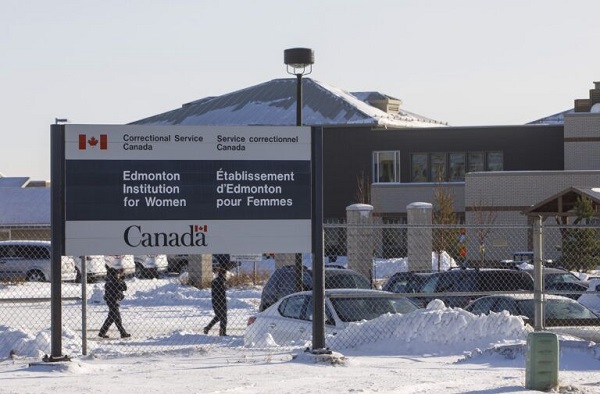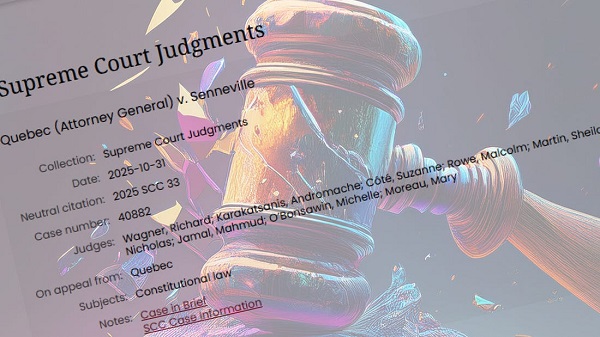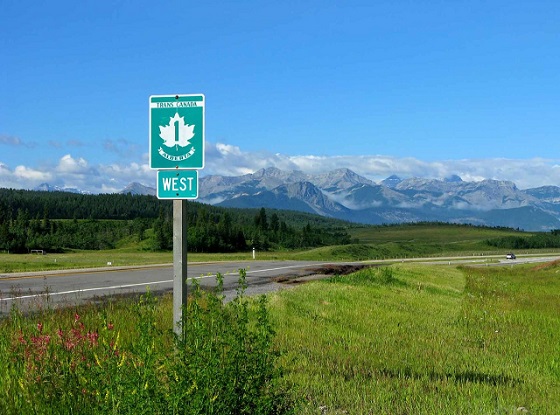Justice
Canadian government sued for forcing women to share spaces with ‘transgender’ male prisoners

The Edmonton Institution for Women, one of six women’s corrections facilities in Canada (Photo credit: The Canadian Press/Jason Franson)
The Justice Centre for Constitutional Freedoms announces that a lawsuit has been launched against the Federal Government, seeking an end to the practice of forcibly confining female inmates of federal prisons with trans-identifying male inmates. The lawsuit claims that this practice is cruel and unusual punishment and violates the Charter rights of female inmates, including “their right to be protected from mental, physical, and sexual abuse…”
The lawsuit was filed on behalf of the national and non-partisan organization Canadian Women’s Sex-Based Rights (CAWSBAR) with the Federal Court of Canada in Toronto on April 7, 2025.
Since 2019, CAWSBAR has advocated for a Canada “where women and girls can be assured that their sex-based rights to bodily privacy ,dignity, fairness, and security are upheld both in law and in public policy.”
Their lawsuit takes aim at the Correctional Service Canada’s Commissioner’s Directive 100: Gender Diverse Offenders, which permits the practice of transferring trans-identifying male inmates to any of six women’s prisons across Canada. CAWSBAR is asking the Federal Court to declare that this Directive is of no force or effect.
Their lawsuit references an extensive list of physical and psychological harms female inmates have suffered as a result of being forcibly confined with trans-identifying male prisoners, including sexual assaults, sexual harassment, beatings, stalking, and grooming.
Many female prisoners come from disadvantaged backgrounds that often include past physical and sexual abuse from males. The current practice of having both males and females attend the same group therapy sessions makes it difficult for female inmates to fully participate in the treatment they seek. In advancing CASWBAR’s claim, lawyers will provide the court with evidence of psychological and physical harms that often lead to Post Traumatic Stress Disorder, flashbacks of stressful violent and/or emotionally disturbing events involving men, anxiety, anger, depression, hopelessness, and suicidality.
Female inmates are reluctant to complain about these arrangements. The court document states that complaints “are often viewed by correctional officers and staff as harassment, intolerance, and/or ‘transphobia.’ Female inmates do not speak out for fear of an entry on their institutional record, which will eventually be considered by the Parole Board of Canada, and which could impact the decision to grant or not grant parole.”
CAWSBAR is not the first organization to report on the risks associated with forcibly confining female inmates alongside trans-identifying males. According to 2023 research from the Macdonald-Laurier Institute, “More than 90% (55 of 61) of [trans-identified male] prisoners were incarcerated for violent offences. Of the group, nearly half (25) had a most serious offence that was homicide related and a third (18) had a most serious offense that was sexual in nature. In comparison, fewer than three-in-10 (6 of 21) [trans-identified females] were convicted of homicide related offences. This proportion of [trans-identified males] incarcerated for sexual and homicide-related offences is extraordinarily high compared to the general female prison population.”
Prior to 2017, only males who had completed sex reassignment surgery could be transferred to a women’s prison.
In October 2016, however, Parliament passed Bill-16, which amended the Canadian Human Rights Act to include gender identity and gender expression as prohibited grounds of discrimination. The Corrections and Conditional Release Act was also amended to include gender identity and expression as prohibited grounds of discrimination. Bill-16 became law on June 19, 2017, and Correctional Service Canada responded by drafting policies that authorized the transfer into women’s prisons of males who identify as women but have not necessarily undergone any surgical transitions.
The current policy, Commissioner’s directive 100: Gender diverse offenders, came into effect in May 2022.
CAWSBAR’s lawsuit argues that the current practice violates the constitutionally protected rights of female inmates. Section 7 of the Canadian Charter of Rights and Freedoms guarantees female inmates the right to life, liberty, and security of the person. Section 12 guarantees the right not to be subjected to any cruel and unusual treatment. Section 15 guarantees equality before and under the law as well as the right not to be discriminated against on the basis of sex.
Their lawsuit also references section 28, which reads, “Notwithstanding anything in this Charter, the rights and freedoms referred to in it are guaranteed equally to male and female persons.”
Heather Mason is a CAWSBAR board member and former inmate at the Grand Valley Institution for Women in Kitchener, Ontario. She explained the reason for her organization’s involvement and her personal motivation. “We initiated this action,” she stated, “to highlight the federal government’s failure to protect women and to raise public awareness about the cruel and unusual punishment that incarcerated women endure as a result of this transfer policy,” she says.
“This matter is especially important to me as a former federal prisoner,” Ms. Mason continued, “I firmly believe that all women are entitled to sex-based rights and protections as specified in the Canadian Charter of Rights and Freedoms.”
John Carpay, President of the Justice Centre, stated, “This lawsuit is a pivotal stand for the safety and dignity of female inmates, challenging a policy that disregards their Charter-protected rights and exposes them to intolerable harm. It underscores the urgent need to prioritize the security of vulnerable women over ideological directives.”
Justice
Carney government lets Supreme Court decision stand despite outrage over child porn ruling

From LifeSiteNews
The Canadian federal government will not be looking to overturn via a constitutional tool the recent Canadian Supreme Court ruling that a mandatory one-year sentence for possessing or accessing child pornography is “unconstitutional.”
Earlier this week, Justice Minister Sean Fraser told the media that the federal government will not override the Supreme Court ruling via the use of the notwithstanding clause.
Fraser claimed that there are “other solutions” that can be used to protect children, including new laws but did not give any concrete examples.
As reported by LifeSiteNews, on October 31, the Supreme Court of Canada ruled that a mandatory one-year sentence for possessing or accessing child pornography is “unconstitutional” and said that it is now up to judges’ discretion to give out sentences.
Conservative Premiers Doug Ford of Ontario and Danielle Smith of Alberta, along with federal Conservative Party leader Pierre Poilievre, all blasted the ruling.
Event left-leaning premiers such as Manitoba’s Wab Kinew blasted the Supreme Court ruling.
As reported by LifeSiteNews, Kinew recently suggested that people should “bury” those found in possession of child pornography under the prison” in response to the Canadian Supreme Court ruling.
Smith had harsh words after the court ruling as well.
“This decision is outrageous. The possession of child pornography is a heinous crime, and even a one-year minimum sentence is already far too lenient,” she wrote on X.
Smith, along with Conservative leader Pierre Poilievre, has called upon the Carney Liberals to invoke the Constitution’s notwithstanding clause to overturn the ruling.
Thus far, Carney has not spoken about the ruling.
Justice
A Justice System That Hates Punishment Can’t Protect the Innocent

Five judges decided that child exploitation isn’t worth a year in prison
What the hell is going on in Canada?
Quebec (Attorney General) v. Senneville – SCC Cases
This isn’t a legal debate. This isn’t a constitutional nuance. This is a collapse. A collapse of morality, of justice, of basic human decency.
This week, the Supreme Court of Canada ruled—by a 5-4 vote—that handing a child pornographer a one-year prison sentence is cruel and unusual punishment. Yes, really. According to the highest court in the land, asking a man who hoarded videos of children—actual children—being raped… to serve twelve months behind bars… is too much to ask. It’s excessive. It’s unfair.
ARE YOU HEARING THIS?!!!!?!!!!?
Let’s talk about the two men at the center of this decision. Not hypotheticals. Not academic theories. Real men. Real crimes. Real victims.
Louis-Pier Senneville—a former soldier, no less—pleaded guilty to possessing over 470 files, 90 percent of which featured young girls aged 3 to 6. Think about that. Three years old. These weren’t gray-area images. These were children, babies, being sodomized, penetrated, used like objects. And he didn’t stumble across them—he looked for them, on specialized sites, and kept them for over a year.
Mathieu Naud? He went even further. 531 images, 274 videos, kids aged 5 to 10. Anal, vaginal, oral rape. These are things no human being should even have to read about—let alone sit in front of a computer and download, categorize, and distribute. Which he did. For months. With software designed to erase his tracks.
This isn’t some “first-time slip-up.” This is deliberate, targeted, depraved behavior. And now?
90 days.
9 to 11 months.
That’s the punishment.
That’s what the Canadian justice system thinks these crimes are worth.
Because five justices decided that asking a pedophile to spend one year in prison might be too harsh for a hypothetical offender. Not these offenders. Not the ones with troves of abuse files saved on hard drives. No… some imaginary guy who maybe clicked the wrong link.
This is what liberalism does to a justice system. It corrupts it beyond repair. It starts with empathy for criminals, and ends with judges protecting predators from consequences. Because in the upside-down world of progressive legal theory, the offender is always the victim. And the actual victims—the kids in those videos—are reduced to footnotes. Inconvenient collateral damage.
This decision—this revolting, disgraceful ruling—is not some fluke. It’s not an isolated misfire by a rogue court. It is the natural conclusion of a liberal worldview that refuses to see evil for what it is. A worldview that sees punishment as outdated, that sees moral judgment as offensive, and that sees child predators as victims of circumstance who just need counseling and compassion.
You want to know what happens when you erase right and wrong?
When your leaders worship “inclusivity” more than innocence?
When your courts protect predators more than children?
This happens.
Five judges decided that a man hoarding child rape videos should be treated with mercy.
Not the children in the videos—no. Not the parents whose lives were shattered.
Not the society that expects its institutions to defend the weak and punish the wicked.
No, mercy for the predator. ALWAYS FOR THE PREDATOR!!!
And now these men—Senneville and Naud—will be out walking the streets. Free men. Maybe shopping next to you at the grocery store. Maybe living near a school. Because Canada’s highest court decided that a year in prison was just too mean.
This isn’t policy failure. This is moral treason.
It’s going to take more than reform to fix this. It’s going to take an entirely new political order—one that puts children before criminals, justice before hypotheticals, and truth before ideology.
Until then, this isn’t a justice system.
It’s a disgrace.
And every decent person in Canada should be outraged.
-

 Crime22 hours ago
Crime22 hours agoPublic Execution of Anti-Cartel Mayor in Michoacán Prompts U.S. Offer to Intervene Against Cartels
-

 Alberta21 hours ago
Alberta21 hours agoCanada’s heavy oil finds new fans as global demand rises
-

 Bruce Dowbiggin19 hours ago
Bruce Dowbiggin19 hours agoA Story So Good Not Even The Elbows Up Crew Could Ruin It
-

 Environment23 hours ago
Environment23 hours agoThe era of Climate Change Alarmism is over
-

 Addictions20 hours ago
Addictions20 hours agoThe War on Commonsense Nicotine Regulation
-

 Alberta2 days ago
Alberta2 days agoAlberta Announces Members of Class Size and Complexity Committee
-

 armed forces2 days ago
armed forces2 days agoIt’s time for Canada to remember, the heroes of Kapyong
-

 Alberta2 days ago
Alberta2 days agoTell the Province what you think about 120 km/h speed limit on divided highways







